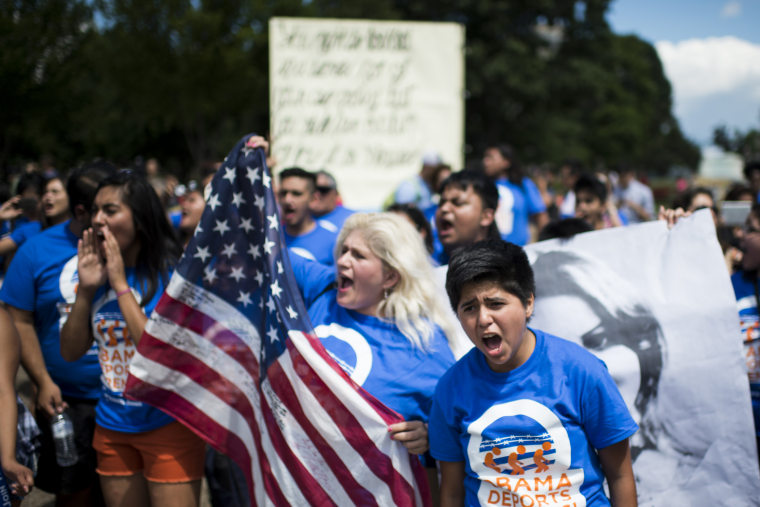It's been three years since President Obama first unveiled his Deferred Action for Childhood Arrivals program, or DACA, radically changing the lives of hundreds of thousands of young undocumented immigrants who were brought to the U.S. as children. Since then, those DREAMers have dramatically reshaped the immigration debate, seen their political clout explode and become ingrained in American culture.
Still, the measure is only temporary -- offering a two-year legal status, work permit and shield from deportation, and researchers are still measuring the many ripple effects of the policy. But as more than 4 million more undocumented immigrants await the outcome of a court battle over the president's latest immigration actions, DACA at its 3rd anniversary, offers a small preview of what to expect if the programs are put back on track.
RELATED: How immigration lawsuit could backfire on the GOP
Benefits go beyond deportation relief -- As Harvard University sociologist Roberto Gonzales has noted, granting temporary documentation to young DREAMers and allowing them to work aboveboard opens new doors beyond the security of knowing they will not be deported.
In his research last year, Gonzales found that 60% of DACA recipients found a new job, while 45% were able to see higher wages. For the first time, DREAMers could become more integrated in American social and economic institutions, able to open their first bank accounts, increase mobility by getting driver's licenses, pay taxes and start building credit.
Many qualify, but haven't applied -- More than 664,000 undocumented immigrants have received DACA benefits since the program began, with another 244,000 who have renewed their deferred status, according to the latest numbers from the U.S. Citizenship and Immigration Services. Still, those recipients account for just a fraction of the estimated 1.1 million DREAMers who likely qualify.
Advocates and experts say that many of the undocumented immigrants who likely qualify for the program, but haven't applied, don't fit the typical profile of a DREAMer.
Hirokazu Yoshikawa, professor of globalization and education at New York University, says older DREAMers, particularly parents still young enough to qualify for DACA, are often extra distrustful of the government. That makes them less likely to come out of the shadows even though they would likely benefit from the program most during a crucial time of their child’s development.
“Having access to things like a driver’s license, a social security and work status is huge,” Yoshikawa says of DACA-eligible parents. “Two generations of impact are what’s at stake.”
DREAMers are stressed out -- Coming out of the shadows for DACA poses significant benefits for DREAMers, but not all ripple effects are positive.
A sweeping study of undocumented students across the country conducted by the University of California, Los Angeles, found that 35% of college-age students with DACA reported anxiety rates above the clinical cut-off rate.
Marcelo M. Suárez-Orozco, dean of the Graduate School of Education and Information Studies at UCLA who led the study, said researchers were stunned to see the lingering fear associated with deportation.
"The DACA students have significantly higher levels of anxiety -- coming out exposes your family,” Suárez-Orozco explains. “The relative safety and the relative improvement in their conditions makes them more aware that their loved ones are vulnerable.”
Challengers have tried -- and failed -- to bring down DACA -- For those paying close attention to the ongoing legal battle over Obama's 2014 executive actions on immigration, known commonly as DAPA and DACA expanded, the programs they were modeled after sustained a number of legal challenges -- and prevailed.
In April, a notoriously conservative federal appeals court in New Orleans threw out a lawsuit brought by immigration agents and the state of Mississippi, which argued that they would incur significant costs in implementing DACA. The court did not agree.
Other efforts to chip away at the 2012 executive measure have also failed. The latest was in Arizona, where officials denied driver's licenses for DREAMers. A legal battle stretched out for months, forcing the state to begin issuing the IDs to those who qualified. A district court permanently put the issue to bed in January.
A model for the future -- When Obama unveiled his latest rounds of executive actions, the measures were largely based off the success and popularity of DACA. This time around, millions rather than thousands of people will likely qualify, raising the stakes for implementing the new executive actions on a national scale -- if the courts let them.
Audrey Singer, a researcher with the Brookings Institute, studied how DACA was implemented in major regions across the U.S. For the DREAMers with strong ties to U.S. institutions, mainly schools, universities and community groups, had a much higher chance of applying for the program -- crucial lessons for groups
“DAPA has been a test run for a bigger program,” Singer said. “The good thing is all of the organizations and advocates on the ground have been preparing and already have the experience.”
